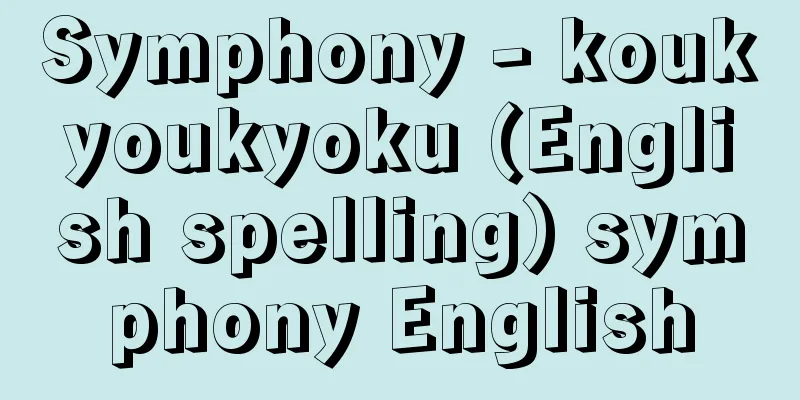Symphony - koukyoukyoku (English spelling) symphony English

|
A classical music term, it is a translation of the Italian word sinfonia or English word symphony, which have been composed for orchestra since the 18th century. The word originates from the Greek words sym (together) and phonia (sound), meaning "perfect harmony". In the 16th to 18th centuries, it was used as the title of vocal music as if it simply meant "music", and was also used for instrumental music in general, including overtures and interludes for operas and oratorios. Its limited meaning is thought to have come about after the 18th century, when it branched off from the similar concerto as a concert instrumental piece, and there was a need to clearly distinguish the modest, smaller-scale "concerto for orchestra" without a solo instrument. Sinfonia (symphonies), which can be performed without a virtuoso violinist, became a popular musical genre in the courts of Germany, which began to have violin orchestras in the mid-18th century, as well as in Italy, where it originated, and the term took on a new meaning. Sinfonia as opera overtures were also performed independently at concerts, and the fact that they were merged into these complicates the history of the establishment of this genre and its name. [Shigeo Osaki] The birth of the symphonyThe shortage of violins and violinists north of the Alps led to the introduction of indigenous wind instruments into orchestras, and each instrument eventually began to play an independent part that made the most of its characteristics. Around 1740, symphonies for an orchestra consisting of two parts each of strings, oboes, and horns were attempted, and the four-movement structure that became the basic style thereafter was also attempted: (1) first movement = fast movement in sonata form, (2) second movement = slow movement, (3) third movement = minuet, and (4) fourth movement = fast movement that may also be in sonata form. The rise of the symphony is related to the fact that the many courts in European society competed to deploy court orchestras, making musical performance an essential component of court life. At this time, the symphony had already surpassed the concerto, which had been the forerunner of orchestral music, to become the most common type of music. According to a survey of 18th century sheet music across all archives, mainly in Europe, the total number of symphonies composed reached 16,558. The expansion and signs of collapse of court society in the second half of the 18th century made it difficult to maintain orchestras in some cases, and court concerts were opened to citizens, or independent public concerts were organized, gradually changing the venue for symphonies. This type of concert, which gathered large audiences in large meeting halls in the city, required a larger volume, and symphonies became larger in scale to meet such occasions and continued to be the main piece of music performed at concerts. For example, Haydn (1732-1809), who began his career as a court musician and ended his life as a citizen artist, about half of his 106 symphonies were for a court orchestra of a dozen people, about a quarter were for a twenty-something person orchestra, and the remaining quarter were ultimately for an orchestra of 60 people. This was accompanied by an increase in the variety of instruments, the establishment of the so-called two-horn arrangement, an expansion of the number of bars and playing time, the development and refinement of the form, and the completion of the symphony as a musical style. [Shigeo Osaki] Classical symphoniesIf the development up to the end of the 18th century is the first stage of the symphony, then the second stage can be said to have begun with Beethoven (1770-1827). The situation changed dramatically all at once. There are various reasons for this, but around this time, the era of the symphony, which had spread to every corner of European court society, came to an end, and the era of the symphony as the largest musical genre in German music, which pioneered the development of civil art and music culture, began. This was a time when nationalism was on the rise in various countries following the Napoleonic Wars, and it can be said that the creation of symphonies directly took on the task of composers at the time of developing and improving German music culture. Especially in the first half of the 19th century, on the one hand, court culture was discontinued, and on the other hand, civil music culture in areas other than Germany was developed mainly around opera, and the creation of symphonies was only an exception. Within this framework, the normative influence that Haydn, Mozart, and especially Beethoven had on subsequent generations of symphony composers is immeasurable. The core of Beethoven's nine symphonies is the four-movement pure instrumental symphony, but No. 6, the Pastoral Symphony, is a program symphony, and the Ninth Symphony, with its chorus, is an oratorio-style symphony, and these three types determined the symphonies that followed. [Shigeo Osaki] After the Romantic PeriodThe series of purely instrumental symphonies was continued by Schubert, Mendelssohn, Schumann, Bruckner, Brahms, and others, and produced the peak of representative works of this genre as a whole. The series of program symphonies was continued by Spohr and Joachim Raff (1822-82), while outside Germany, Berlioz, Franck (symphonic poems before 1848), and Liszt gave original developments, even reaching the symphonic poem. The series of oratorio-type symphonies was finally fully redeveloped by Mahler at the end of the 19th century, and many works in the 20th century continued this trend. In the second half of the 19th century, the already established German concert culture attracted the younger generations from neighboring countries, who also participated in the composition of symphonies. Examples include Saint-Saëns in France, Dvorak in the Czech Republic, Rubinstein and Tchaikovsky in Russia, and Sibelius and Johan Svendsen (1840-1911) in Scandinavia. Thus, in the third stage of the symphony, parallel to the cosmopolitanization of classical music culture in the 20th century, the symphony completely abandoned its German character. With past masterpieces performed in concert halls around the world and recorded on disc, the symphony has been imprinted as a representative large orchestral work in classical music. On the other hand, even if it did not secure a leading position in 20th century music creation, it continued to be composed, including in the United States and Japan. And although there are certainly few new works completed today, the fact that composers still attempt to compose symphonies when they want to convey a message to the world reflects the historicity of this musical genre as a monument. [Shigeo Osaki] "CD Book 'Classics In Vol. 1/The Three Great Symphonies' (1989, Shogakukan)" ▽ "100 CD Masterpieces/Symphonies' by Koishi Tadao (1994, Ongaku No Tomo Sha)" ▽ "Post-Mahler Symphonists - From Elgar and Sibelius to the Present Day' by Isoda Kenichiro (1996, Ongaku No Tomo Sha)" ▽ "Encyclopedia of Masterpiece Recording Appraisals: Symphony Edition' by Yoshii Akihiko (1997, Shunjusha)" ▽ "Masterpieces and Masterpiece Recordings of Symphonies' by Uno Noriyoshi (Kodansha Gendai Shinsho)" ▽ "Symphonies' by R. Jacob, translated by Mochida Akiko and Hirota Ken (Hakusuisha, Que sais-je Bunko)" [References] | | | | | | | | | | | | |Beethoven|Source: Shogakukan Encyclopedia Nipponica About Encyclopedia Nipponica Information | Legend |
|
クラシック音楽の用語で、18世紀以来管弦楽のために作曲されてきた器楽曲シンフォニア(イタリア語)、シンフォニー(英語)の訳語。語源的には「完全なる協和」を意味するギリシア語のsym(ともに)-phonia(響き)に由来する。16~18世紀の用例としては、単に「音楽」の意であるかのように声楽曲の題名にも用いられたほか、オペラやオラトリオの序曲や間奏曲などを含めた器楽曲一般にも使用されていた。それが限定的な意味に向かうのは、18世紀以降、コンサート器楽曲として類似のコンチェルト(協奏曲)と分岐して、独奏楽器のない、地味で、より小規模な「オーケストラのためのコンチェルト」を峻別(しゅんべつ)する必要がおこったためと考えられる。 バイオリンの名手を欠いても音楽演奏を成立させうるシンフォニア(交響曲)は、その発祥の地イタリアと並んで、18世紀中ごろからバイオリン楽団を擁するようになったドイツ各地の宮廷において人気曲種となり、この用語の新しい意味が定着する。オペラ序曲としてのシンフォニアもコンサートで独立して演奏され、ここに合流してくることがこのジャンルと名称の成立史を複雑にしている。 [大崎滋生] 交響曲の誕生アルプス以北におけるバイオリンとその奏者の絶対数の不足は、オーケストラに土着の管楽器を導入することにつながり、やがて各楽器はそれぞれの特性を生かした独立のパートを担うようになっていく。1740年ごろには弦楽合奏とオーボエおよびホルン各2部のオーケストラによる交響曲も試みられるようになり、その後の基本様式である4楽章構成、(1)第1楽章=ソナタ形式をとる急速楽章、(2)第2楽章=緩徐楽章、(3)第3楽章=メヌエット、(4)第4楽章=ソナタ形式をとることもある急速楽章、も試みられる。こうした交響曲の隆盛は、ヨーロッパ社会のあまたの宮廷が宮廷楽団を競って配備して、奏楽を宮廷生活の本質的構成要素としたことと関係がある。すでにこの時点で交響曲は、オーケストラ音楽として先輩格であった協奏曲をしのいで、そのもっとも一般的な曲種となった。ヨーロッパ地域を中心とする全資料館を対象とした、18世紀楽譜の調査によると、交響曲の創作量は1万6558曲にも達していた。 18世紀後半における宮廷社会の拡大と崩壊の兆しは、楽団の維持を場合によって困難にして、宮廷コンサートは市民に開放され、あるいは独自に公開演奏会が企画されて、交響曲の場はしだいに変化する。街なかの大きな集会所等に大勢の人を集めたこの種のコンサートは、より大きな音量が求められるようになっていったが、交響曲はそのような機会に沿う形で大規模化していき、演奏会の中心的演奏曲目であり続けた。宮廷楽師として経歴を開始し、市民芸術家としてその生涯を終えたハイドン(1732―1809)を例にとると、106曲の交響曲のうち約半分が十数人編成の宮廷楽団のためのものであり、二十数人規模の約4分の1を経て、残りの約4分の1は最終的に60人規模の編成を前提としている。これには楽器の種類の増大と、いわゆる2管編成の定着、小節数や演奏時間の拡張、形式の開発や整備、そして音楽様式としての交響曲の完成、が伴っている。 [大崎滋生] 古典派の交響曲18世紀末までの展開を交響曲の第1ステージとすれば、第2ステージはベートーベン(1770―1827)をその開始点にするといってよい。それほど劇的に局面は一気に転換したといえる。その理由はさまざまであるが、このころを境に、ヨーロッパの宮廷社会の隅々に行き渡っていた交響曲の時代は終わって、市民的芸術音楽文化を先駆的にはぐくんでいったドイツ音楽における、最大の曲種としての交響曲の時代が始まる。時はナポレオン戦争を期にナショナリズムが諸国で高まっていく時代であり、ドイツ音楽文化の発展・向上という当時の作曲家の課題を交響曲創作が直接的に担ったといえる。ことに19世紀前半は、一方で宮廷文化が途絶え、他方ドイツ以外の地域では市民的音楽文化がオペラを中心に展開され、交響曲の創作は例外的にしかなかった。こうした枠組みのなかでハイドン、モーツァルト、そしてとりわけベートーベンが次代の交響曲作曲家たちに与えた規範的影響力は計り知れない。ベートーベンの交響曲9曲の作品の中核は4楽章構成の純器楽交響曲だが、第6番『田園交響曲』は標題交響曲、合唱付きの『第九交響曲』はオラトリオ型交響曲であり、この3種がその後の交響曲を決定づけた。 [大崎滋生] ロマン派以降純器楽交響曲の系列はシューベルト、メンデルスゾーン、シューマン、ブルックナー、ブラームスらの創作によって受け継がれ、この曲種全体の代表的な作品の峰々が生まれる。標題交響曲の系列はシュポーア、ラフJoachim Raff(1822―82)らに継承される一方、またドイツ圏外ではベルリオーズ、フランク(1848年以前の交響詩)、リストによって独創的な発展を遂げて、交響詩にまで至る。オラトリオ型交響曲の系列は、19世紀末のマーラーによってようやく本格的に再開発され、20世紀にもその傾向を継承した作品は少なくない。 19世紀後半に入ると、すでに確立されていたドイツのコンサート文化は周辺各国の若い世代をひきつけ、彼らが交響曲の創作にも参入してくる。フランスのサン・サーンス、チェコのドボルザーク、ロシアのルービンシュテインやチャイコフスキー、北欧のシベリウスやスベンゼンJohan Svendsen(1840―1911)らがその一例である。こうして交響曲の第3ステージとして、20世紀におけるクラシック音楽文化のコスモポリタン化と平行して、交響曲はそのドイツ性を完全に捨て去る。 これまで全世界のコンサート・ホールで過去の名作が演奏され、またディスクに録音されて、交響曲はクラシック音楽の代表的な大管弦楽曲種として刻印されてきた。その一方、20世紀の音楽創作において主役の座は確保できなかったとしても、アメリカや日本を含めて、それは創作され続けた。そして今日では、新作の完成は確かに少ないものの、作曲家が世界にメッセージを伝えたいときなどには交響曲の創作がなお試みられるところに、この曲種の記念碑としての歴史性が映し出されている。 [大崎滋生] 『CDブック『クラシック・イン第1巻/三大交響曲』(1989・小学館)』▽『小石忠男著『CD名曲名盤100/交響曲』(1994・音楽之友社)』▽『磯田健一郎著『ポスト・マーラーのシンフォニストたち――エルガー、シベリウスから現代まで』(1996・音楽之友社)』▽『吉井亜彦著『名盤鑑定百科 交響曲篇』(1997・春秋社)』▽『宇野功芳著『交響曲の名曲・名盤』(講談社現代新書)』▽『R・ジャコブ著、持田明子・広田健訳『交響曲』(白水社・文庫クセジュ)』 [参照項目] | | | | | | | | | | | | | | |出典 小学館 日本大百科全書(ニッポニカ)日本大百科全書(ニッポニカ)について 情報 | 凡例 |
>>: Agency of Industrial Science and Technology
Recommend
Ol'ga Fyodorovna Berggol'ts (English spelling)
A Russian female poet. Graduated from the Faculty...
Small intestine
It is a long, thin digestive tract that continues...
Roman glass
A general term for glassware made within the Roman...
"The Golden Age" (theater)
...This performance, together with the sequel &qu...
Higashimatsuyama [city] - Higashimatsuyama
A city in central Saitama prefecture. It was incor...
Temae - Tea ceremony
In the tea ceremony, this refers to the act of pr...
Sosius Senecio, Q. (English spelling) SosiusSenecioQ
…The original work included many more people, but...
Wind God and Thunder God
Of the natural phenomena that show such great powe...
Acker
American playwright, novelist, and poet. Her works...
Vaterland
…In response, Germany built ships such as the Imp...
Ghats [mountain range] - Ghats
A mountain range that runs north to south on both ...
Ethyl acetoacetate (English spelling)
...These abnormal metabolic products are found in...
Konya Takao
One of the classic Rakugo pieces. Also known as &q...
Covered
...When a publication whose printing plate has al...
Tamamushi Sadayu
Year of death: 9th May 1869 (Meiji 2) Year of birt...









